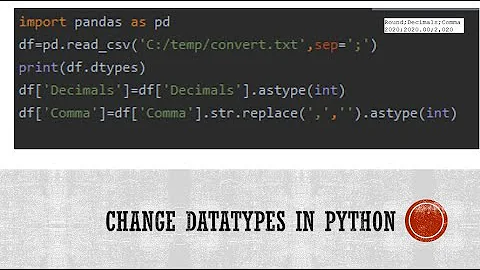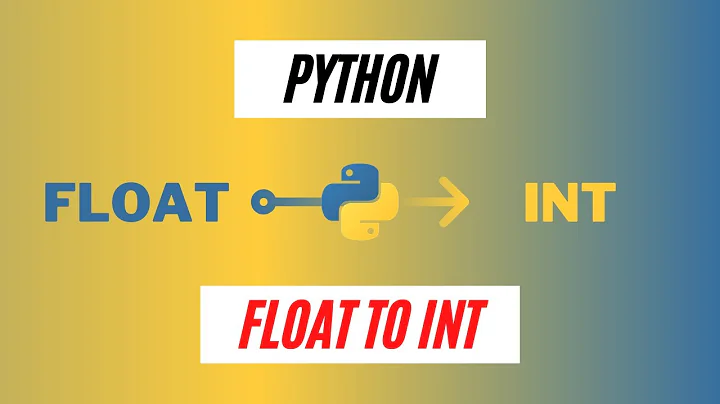Safest way to convert float to integer in python?
Solution 1
All integers that can be represented by floating point numbers have an exact representation. So you can safely use int on the result. Inexact representations occur only if you are trying to represent a rational number with a denominator that is not a power of two.
That this works is not trivial at all! It's a property of the IEEE floating point representation that int∘floor = ⌊⋅⌋ if the magnitude of the numbers in question is small enough, but different representations are possible where int(floor(2.3)) might be 1.
To quote from Wikipedia,
Any integer with absolute value less than or equal to 224 can be exactly represented in the single precision format, and any integer with absolute value less than or equal to 253 can be exactly represented in the double precision format.
Solution 2
Use int(your non integer number) will nail it.
print int(2.3) # "2"
print int(math.sqrt(5)) # "2"
Solution 3
You could use the round function. If you use no second parameter (# of significant digits) then I think you will get the behavior you want.
IDLE output.
>>> round(2.99999999999)
3
>>> round(2.6)
3
>>> round(2.5)
3
>>> round(2.4)
2
Solution 4
Combining two of the previous results, we have:
int(round(some_float))
This converts a float to an integer fairly dependably.
Solution 5
That this works is not trivial at all! It's a property of the IEEE floating point representation that int∘floor = ⌊⋅⌋ if the magnitude of the numbers in question is small enough, but different representations are possible where int(floor(2.3)) might be 1.
This post explains why it works in that range.
In a double, you can represent 32bit integers without any problems. There cannot be any rounding issues. More precisely, doubles can represent all integers between and including 253 and -253.
Short explanation: A double can store up to 53 binary digits. When you require more, the number is padded with zeroes on the right.
It follows that 53 ones is the largest number that can be stored without padding. Naturally, all (integer) numbers requiring less digits can be stored accurately.
Adding one to 111(omitted)111 (53 ones) yields 100...000, (53 zeroes). As we know, we can store 53 digits, that makes the rightmost zero padding.
This is where 253 comes from.
More detail: We need to consider how IEEE-754 floating point works.
1 bit 11 / 8 52 / 23 # bits double/single precision
[ sign | exponent | mantissa ]
The number is then calculated as follows (excluding special cases that are irrelevant here):
-1sign × 1.mantissa ×2exponent - bias
where bias = 2exponent - 1 - 1, i.e. 1023 and 127 for double/single precision respectively.
Knowing that multiplying by 2X simply shifts all bits X places to the left, it's easy to see that any integer must have all bits in the mantissa that end up right of the decimal point to zero.
Any integer except zero has the following form in binary:
1x...x where the x-es represent the bits to the right of the MSB (most significant bit).
Because we excluded zero, there will always be a MSB that is one—which is why it's not stored. To store the integer, we must bring it into the aforementioned form: -1sign × 1.mantissa ×2exponent - bias.
That's saying the same as shifting the bits over the decimal point until there's only the MSB towards the left of the MSB. All the bits right of the decimal point are then stored in the mantissa.
From this, we can see that we can store at most 52 binary digits apart from the MSB.
It follows that the highest number where all bits are explicitly stored is
111(omitted)111. that's 53 ones (52 + implicit 1) in the case of doubles.
For this, we need to set the exponent, such that the decimal point will be shifted 52 places. If we were to increase the exponent by one, we cannot know the digit right to the left after the decimal point.
111(omitted)111x.
By convention, it's 0. Setting the entire mantissa to zero, we receive the following number:
100(omitted)00x. = 100(omitted)000.
That's a 1 followed by 53 zeroes, 52 stored and 1 added due to the exponent.
It represents 253, which marks the boundary (both negative and positive) between which we can accurately represent all integers. If we wanted to add one to 253, we would have to set the implicit zero (denoted by the x) to one, but that's impossible.
Related videos on Youtube
Boaz
Updated on October 30, 2021Comments
-
Boaz over 2 years
Python's math module contain handy functions like
floor&ceil. These functions take a floating point number and return the nearest integer below or above it. However these functions return the answer as a floating point number. For example:import math f=math.floor(2.3)Now
freturns:2.0What is the safest way to get an integer out of this float, without running the risk of rounding errors (for example if the float is the equivalent of 1.99999) or perhaps I should use another function altogether?
-
 sancho.s ReinstateMonicaCellio about 8 years
sancho.s ReinstateMonicaCellio about 8 yearsmath.floorreturns a float in v2.6, but it returns an integer in v3. At this point (almost six years after the OP), this issue might show up rarely. -
 Vincenzooo over 5 yearshowever numpy still returns float, so the question is valid.
Vincenzooo over 5 yearshowever numpy still returns float, so the question is valid. -
 WurmD over 3 yearsThe title could be improved to "Safest way to round down and convert float to integer in python?"
WurmD over 3 yearsThe title could be improved to "Safest way to round down and convert float to integer in python?"
-
-
Gordon Gustafson almost 14 years+1 for going a bit deeper. You could also throw in a brief explanation as to why: en.wikipedia.org/wiki/Floating_point :D
-
Philipp almost 14 years
roundreturns a float number as well, at least in Python 2.6. -
robert almost 14 yearsIn Python 3.1.2, round returns an int.
-
Philipp almost 14 yearsIndeed, both
roundandfloorreturn integers in Python 3.x. So I suppose that the question concerns Python 2.x. -
Wayne Werner almost 14 yearsand since (it appears that) the OP is using IPython which isn't available for py3k, that's probably a valid supposition, Phillip.
-
Bill Rosmus almost 11 yearsFrom: docs.python.org/2/library/math.html - math.floor(x) - Return the floor of x as a float, the largest integer value less than or equal to x.
-
jochen almost 10 yearsThis won't work for negative numbers:
floorrounds down whereasintrounds towards 0. -
 srodriguex almost 10 years@jochen I tested
srodriguex almost 10 years@jochen I testedint(-2.3)in Python distribution Canopy 2.7.6 and got-2as expected. Integer numbers can be negative, the same way in formal Math definition. -
jochen almost 10 yearsI agree,
int(-2.3)gives-2as you say, because it rounds towards0, i.e. up in this case. In contrast, the original question usedmath.floor, which always rounds down:math.floor(-2.3)gives-3.0. -
teewuane over 9 yearsso maybe
int(round(2.65))? -
Agostino about 9 yearsWhat happens if you try to round a very long float? Will this at least raise an exception?
-
JMTyler over 8 yearsThat is not really a problem. OP just wants an integer out of the result of
math.floor, and this answer shows how to convert a float into an integer. Take the float frommath.floorand pipe it throughint, problem solved:int(math.floor(2.3)) -
kralyk about 8 years@Agostino What do you mean "very long float"?
-
Agostino about 8 years@kralyk I mean a
floatrepresenting a number bigger than what a normalintcan hold. In Python 2, are therefloatvalues that you can only represent using along(after rounding)? -
Agostino about 8 years@kralyk you mean, after the round? So, would casting them to int raise an exception, or just truncate them?
-
kralyk about 8 years@Agostino No, the
int()function produces either anintor alongbased on what is needed... -
kralyk about 8 years@Agostino docs.python.org/2/library/functions.html#int , it says "If x is a number, it can be a plain integer, a long integer, or a floating point number." which is what applies in this situation.
-
Agostino about 8 years@kralyk thanks, maybe we can clean up the comments and add a note to the answer?
-
kralyk about 8 years@Agostino I suppose we can yeah
-
Mayou36 over 7 yearsDid you even read the question? He is aware of the int() function, but has asked if you may run into trouble with 1.9999 instead of 2.0. Your answer is not even close to an answer at all, you missed the whole point...
-
 srodriguex over 7 years@Mayou36 It seems I missed the point, but it's what I wrote with the knowledge I had at the time, so let it be. The community will vote up or down as they see fit. But, I really think it holds:
srodriguex over 7 years@Mayou36 It seems I missed the point, but it's what I wrote with the knowledge I had at the time, so let it be. The community will vote up or down as they see fit. But, I really think it holds:int(-999999999980/99999999999) == -9 # True -
candh almost 7 yearswhy does
round(6.5)gives 6? It seems to kindaceil()the float when there's an immediate 5 (or greater up to 9) after the decimal in all other cases. Why is this not working in this case? or any other case when the number ends with a six and there's a 5 right after the decimal... -
Alex over 6 yearsWhy do you need to do call math.floor when int already does the same thing?
-
 Admin over 6 years@Alex:
Admin over 6 years@Alex:intandfloorreturn different values for negative numbers, of course. -
Juan over 6 yearsIn Python 2, an "int" is the same as a C "int". In Python 3, it appears there is no limit to the size of an "int, stackoverflow.com/questions/13795758/…. The meaning of "int" is also dependent on the operating system and underlying hardware. See en.wikipedia.org/wiki/64-bit_computing#64-bit_data_models. If you are programming with the C-API, python 3 you have to be very careful in what the definition of long and size_t is on your platform. docs.python.org/3/c-api/long.html
-
Nirvana almost 3 yearscandh I believe it uses "banker's rounding"/"rounding half to even" method– rather than rounding 0.5 and higher up, and 0.4 and lower down, it rounds 0.5 to the nearest even number.
-
 Tatarize over 2 yearsint(float('inf')) raises an Overflow Error.
Tatarize over 2 yearsint(float('inf')) raises an Overflow Error.





